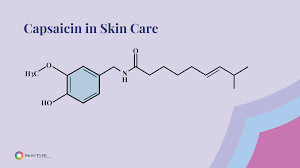
The Science of Capsaicin in Skin Care
Capsaicin is commonly known as a powerful plant compound found in chili peppers, but while capsaicin gives chili peppers their infamous fiery kick, it also has a secret soothing ability that makes it one of the most unique anti-inflammatory ingredients in skin care today.
It exerts powerful anti-inflammatory behavior, resulting in long term relief for conditions like eczema, psoriasis and others.
Intrigued? Keep reading to uncover the science behind capsaicin in skin care and learn why studies on this ingredient are more common now than ever before.
Take the Baumann Skin Type quiz for free today to see if this and other ingredients are right for your skin type!
What is Capsaicin
Capsaicin is the compound that makes spicy peppers spicy (10). It is found in varieties like habanero, scotch bonnet, jalapeños, and cayenne (10). Chemically, capsaicin is classified as a phenylpropanoid, an organic compound found in many plants.
Capsaicin is produced by peppers as a defense mechanism against threats like fungi, insects, and small mammals (10). The burning sensation that capsaicin causes is meant to deter these potential predators, but instead, we eat it and put it on our faces.
Where does Capsaicin come from?
As mentioned above, capsaicin is naturally found in chili peppers, with the highest concentrations occurring in hotter pepper varieties (10).
For skin care products, capsaicin is chemically synthesized in a lab to the exact chemical structure that occurs in peppers (10). This allows manufacturers to control the concentration used in topical creams, ointments, and serums.
Benefits of capsaicin
Capsaicin is gaining interest in the skin care world because of several beneficial properties:
Anti-inflammatory – Capsaicin has potent anti-inflammatory effects, which can help reduce redness and swelling associated with conditions like eczema, psoriasis, and others (1,4).
Pain relief – By binding to pain receptors, capsaicin initially activates neurons before causing them to become desensitized, effectively alleviating pain (1,3,4). It’s kind of like fighting fire with fire.
Psoriasis treatment – Research shows that topical application of capsaicin can reduce scaling, thickness, redness and itching associated with psoriasis lesions (4,5).
Cellulite reduction – Capsaicin may interfere with the way fat is processed in the body, showing evidence of treating cellulite in studies (8).
Antioxidant – Capsaicin demonstrates free radical scavenging ability in lab tests, suggesting it may have antioxidant properties in skin care formulations (7).
Capsaicin risks and side-effects
Capsaicin risks and side effects
While capsaicin shows promise for many skin therapies, it also comes with some potential side effects to be aware of:
Irritation – Capsaicin is highly irritating to skin, especially in higher concentrations. Burning, stinging, redness and dryness can occur (4,6).
Toxicity – Concerns about capsaicin’s toxicity are controversial. Some older studies link it to cancer while newer research suggests anti-cancer properties (2). Further study is needed on its interactions with cancer.
Breastfeeding – Capsaicin applied topically can enter breastmilk, possibly impacting infant health (4). Nursing mothers should exercise caution.
Neurotoxicity – High doses of capsaicin may have neurotoxic effects leading to nerve damage, although this is unlikely with topical use (4).
Is Capsaicin toxic?
The toxicity of capsaicin is still up for debate. Some older studies raise concerns about carcinogenic effects, while newer research suggests it may actually have anti-cancer properties (2). Most experts agree that topical use of capsaicin is likely safe, as the amount penetrating skin is very minimal (4). However those who are pregnant/nursing or have other health concerns should consult a doctor before using.
How does capsaicin treat inflammation?
How does Capsaicin treat inflammation?
Capsaicin can help reduce inflammation from a variety of causes. What makes capsaicin interesting is the unique mechanism by which it treats inflammation and pain.
First, capsaicin triggers sensory neurons in the skin. This causes a burning or stinging feeling. This stinging can be modified based on the concentration of capsaicin in a product.
Second, after regular use, capsaicin causes the sensory neurons to become less sensitive. This lessens the activity neurotransmitters. It stops the neurons from sending pain and itch signals related to inflammation.
Additionally, capsaicin blocks an inflammatory pathway called NF-kB. This pathway activates inflammatory cytokines – proteins that drive inflammation. With NF-kB blocked, there are lower levels of inflammatory cytokines.
In summary, capsaicin first provides temporary pain relief through basically desensitizing your skin. Later, it relieves long term inflammation as neurons become less sensitive and cytokine production is lowered. This unique 2-step process makes capsaicin helpful for chronic inflammatory skin problems like psoriasis.
Capsaicin for cellulite
Cellulite is characterized by dimpled, uneven areas of skin, typically on the thighs and buttocks. It results from fat cells and connective tissue deformities beneath the skin. Though harmless, many people seek ways to reduce the appearance of cellulite.
Early research indicates that capsaicin may help smooth the appearance of cellulite when applied topically. One study found that applying 0.3% capsaicin cream to the thighs daily for 6 weeks led to smoother skin texture and reduced visible cellulite compared to placebo cream (8).
How does capsaicin improve the appearance of cellulite? It’s believed to work in a couple ways:
Altering fat metabolism – Capsaicin appears to stop the accumulation of fats within adipocytes (fat cells) in cellulite-prone areas (8). This may reduce fat clumps that lead to a dimpled look.
Boosting blood flow – Increased blood flow can help reduce tissue inflammation that makes cellulite more visible. Capsaicin’s short-term irritation effect induces inflammation followed by increased localized blood flow (8).
While early results are promising, more research is still needed to fully understand capsaicin’s effects on cellulite.
As more research is being conducted on capsaicin regularly, this is currently the only product we offer with this ingredient:
Capsaicin for anti-aging
Some early research indicates that capsaicin has antioxidant properties that may help slow signs of aging on the skin, such as wrinkles and sagging skin (7). By eliminating free radicals on the skin, capsaicin can contribute to younger looking skin over time. More research is still needed in this area.
Capsaicin for hyperpigmentation
By interfering with melanin synthesis and maturation, capsaicin shows potential for improving hyperpigmentation issues, including melasma, freckles and sun spots(9). With regular application, you could expect to notice lighter, more even skin tone when using it alongside other skin lightening ingredients such as:
Azelaic acid
Cysteamine
Hexylresorcinol
Retinol
Salicylic acid
Capsaicin vs ricinoleic acid
Capsaicin vs Ricinoleic acid
I have heard comparisons between capsaicin and the active ingredient in castor oil, ricinoleic acid. Here is a brief comparison of these two ingredients.
Both capsaicin and ricinoleic acid have anti-inflammatory effects that can help reduce swelling and irritation in skin. However, they differ in their mechanisms of action and side effects:
Capsaicin provides temporary pain relief through initial triggering of sensory neurons, followed by longer term desensitization. This causes an initial burning or stinging sensation on the skin.
Ricinoleic acid does not cause any initial burning, but gradually reduces inflammation and pain over several days of repeated use. It does this through different pathways than capsaicin.
The fatty acid ricinoleic acid also has emulsifying properties that allow it to break down fats and oils. Capsaicin does not share this ability.
Ricinoleic acid appears to be less irritating to skin, while capsaicin is known for its irritating side effects like redness, dryness and flaking.
So in summary, both ingredients reduce inflammation, but ricinoleic acid’s more gradual, non-irritating effects may make it preferable for some individuals with sensitive skin. However, capsaicin may provide faster initial relief. For these reasons and others, castor oil is more popular than capsaicin in skin care for many of the same treatments. Here are some of my favorite products with ricinoleic acid-rich castor oil:
Conclusion
While research shows capsaicin has potential benefits for skin health, there are several factors that limit its widespread use in skincare products:
Irritation – Capsaicin often causes burning, stinging, redness and dryness, especially in higher concentrations. Many consumers find this too irritating.
Lack of research – Much of the research on capsaicin for skin is still in early stages or limited in scope. More clinical trials are needed to convince skincare companies to adopt it.
Effectiveness concerns – It’s unclear if the small amount of capsaicin able to penetrate skin provides enough anti-inflammatory or antioxidant benefit compared to other ingredients.
Availability – Since it must be chemically synthesized to be under control, capsaicin is more expensive than most plant extracts used in skincare. The supply chain is limited.
Safety fears – While topical use is likely safe, there are lingering concerns about capsaicin’s toxicity if absorbed into your bloodstream. This deters some skincare brands.
In summary, capsaicin shows promise but needs more research to confirm benefits. It may gain more popularity if formulations can optimize delivery while minimizing irritation.
To find out if capsaicin or ingredients like it are right for your skin type, take the Baumann Skin Type Quiz for free today!


